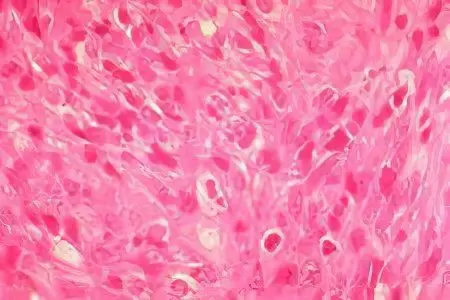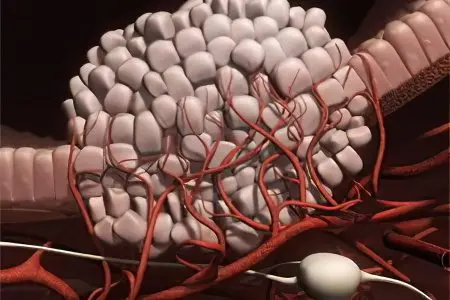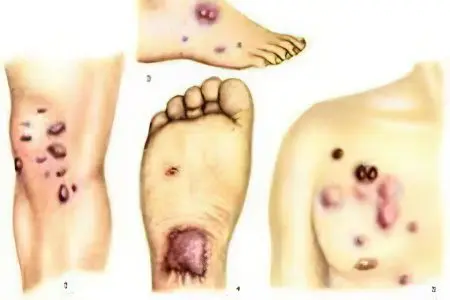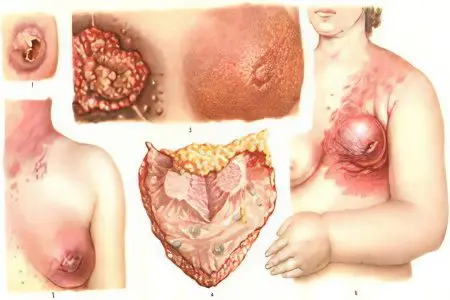Contents
What is a sarcoma?
Sarcoma – this is one of the varieties of malignant neoplasms emanating from the cellular elements of the connective tissue. Since there is not a single organ and anatomical segment in the human body that does not contain connective tissue, sarcoma does not have a strict localization. Any parts of the human body are subject to such tumor transformation. In practice, this is associated with conflicting statistics, according to which only 5% of all malignant neoplasms are sarcomas. But their peculiarity is such that the occurrence of such a tumor is associated with high mortality. Another feature of sarcomas is the predominant occurrence at a young age during the period of active growth of the body (the age of more than 35% of patients is less than 30 years).
General characteristics of sarcoma:

High degree of malignancy;
Invasive type of growth with germination of surrounding tissues;
Growth to large sizes;
Frequent and earlier metastasis to the lymph nodes and internal organs (liver, lungs);
Frequent relapses after removal of the tumor.
Each of the types of sarcomas has favorite places of growth, age limits, connection with a certain gender and other factors. They differ from each other macroscopically and histologically, in the degree of malignancy, different propensity for metastasis and recurrence, depth of germination and prevalence. The vast majority of sarcomas grow in the form of nodes of different sizes and shapes, do not have clear boundaries, and on the cut they resemble fish meat of a pale gray hue with areas of necrosis and a different number of vessels. Some sarcomas are characterized by rapid growth (weeks, months), but there are also tumors with a slow growth type (years, decades). Tumors of this type are always well supplied with blood.
The most common localization of sarcoma
The main derivatives of connective tissue in the body are bones, blood vessels, muscles, ligaments, tendons, fascia, connective tissue membranes and capsules of internal organs and nerves, connective tissue constrictions of adipose tissue and cellular spaces.
Depending on this and localization, tumor growth is most susceptible to:
bones of the limbs;
Soft tissues of the extremities (together with bone sarcomas, they account for 60% of all sarcomas);
Soft tissues and bones of the body;
Soft tissues, cellular spaces and bones of the head and neck;
Connective tissue elements of the mammary glands and uterus;
Fiber of the retroperitoneal space;
Other rare localizations (internal organs, abdominal and pleural cavities, mediastinum, brain and peripheral nerves).
Histological classification and types of sarcoma
Among all malignant tumors, sarcoma has the greatest variety of histological types. Sarcomas include:
A type of sarcoma | The structure and description of the tumor |
Osteosarcoma | Formed from the cellular components of bone tissue |
Chondrosarcoma | Represented by cartilage |
Paraostial sarcoma | Formed from the periosteum and surrounding tissues |
Reticulosarcoma | Tumor growth from bone marrow elements |
Ewing’s sarcoma | A type of osteosarcoma that predominantly affects the end sections of the long bones of the limbs |
Fibrosarcoma | Tumor of connective tissue elements and fibrous fibers |
Angiosarcoma | The basis of the tumor is the growth of vascular elements |
Stromal sarcomas of the gastrointestinal tract and other internal organs | Originate from the connective tissue that makes up the stroma of any organ |
Liposarcoma | Tumor growing from adipose tissue |
Rhabdomyosarcoma | The predominance of elements of striated muscles |
Kaposi’s sarcoma | Multiple tumor growths of blood vessels of the skin and lymphoid tissue against the background of immunodeficiency |
Lymphangiosarcoma | Tumor with proliferation of components of the lymphatic vessels |
Dermatofibrosarcoma | Tumor from skin structures with a connective tissue base |
Synovial sarcoma | Tumor growth of their synovial membranes of the joints |
Lymphosarcoma | Tumor growth from lymphoid tissue |
Neurofibrosarcoma | Arises from nerve sheaths |
Fibrous histiocytoma | Contains different types of connective tissue cells and fibers |
Spindle cell sarcoma | Affects mucous membranes and consists of large spindle-shaped cells |
Mesothelioma | The substrate of the tumor can be the mesothelium of the pericardium, peritoneum and pleura |
The degree of differentiation of sarcoma

Not always, even under a microscope, one can clearly distinguish the structure of the sarcoma and its histological type. The most important thing that must be established is the very fact of the origin of the tumor from the connective tissue and the degree of its differentiation.
Depending on this, there are:
Poorly differentiated sarcomas. Tumors of this type have the lowest degree of malignancy, since their structure is not similar to the tissues from which they grow. They practically do not metastasize, grow slowly, are large, removal rarely causes relapses;
Highly differentiated sarcomas. They are the absolute opposite of low-differentiated. In structure, they are similar to those tissues from which they originate, highly malignant, grow rapidly, metastasize early, and are difficult to surgical treatment;
Moderately differentiated sarcomas. Occupy an intermediate position between the previous types.
Symptoms of sarcoma
The clinical picture of sarcoma depends on the location and characteristics of its malignancy. The main symptoms of the disease are shown in the table.
Group of symptoms | Manifestations |
Pain syndrome |
|
The appearance of a tumor |
|
Violation of the function of the affected organ or segment |
|
Invasion of surrounding tissues |
|
Diagnosis of sarcoma

The presence of any symptoms of sarcoma is a direct indication for its confirmation or exclusion as soon as possible.
The following diagnostic methods can help with this:
X-ray examination with suspicion of osteosarcoma and other bone tumors;
Ultrasound examination soft tissues or internal organs;
Tomography. For bone tumors, it is more appropriate to perform computed tomography. Soft tissue tumors are better seen on MRI;
Radioisotope diagnostic methods. Their diagnostic significance increases with deep localization of tumors in cavities and cellular spaces;
Tumor biopsy. With superficial tumors is not difficult. Deeply located tumors can only be examined under ultrasound or tomographic control;
Angiography. The contrast agent injected into the arteries determines the local accumulation of vessels at the site of tumor growth and the nature of circulatory disorders below the site of sarcoma growth.
Causes of sarcoma
Any types of sarcomas, like all malignant neoplasms, are polyetiological diseases that occur under the influence of many causative factors. They are rarely identified.
The main culprits of the tumor transformation of the connective tissue can be:
Burdened hereditary history and genetic predisposition;
The damaging effect of ionizing radiation on the DNA of cells;
The impact of oncogenic viruses on cells that trigger the mechanisms of uncontrolled division;
Violation of lymphatic drainage after operations and pathological processes;
Congenital and acquired immunodeficiencies, HIV infection;
Courses of chemotherapy and treatment with immunosuppressive drugs;
Transplantation of internal organs;
Traumatic injuries, extensive and long-term non-healing wounds, non-extracted foreign bodies of soft tissues.
Sarcoma stages

The division of sarcomas into stages is based on:
The size of the primary tumor;
Spread beyond the capsule of the organ or fascia of the anatomical formation from which the sarcoma grows (muscles, bones, tendons, etc.);
Involvement in the process and germination of surrounding tissues;
The presence of metastases in regional lymph nodes;
Presence of metastasis to distant organs.
The histological type of the tumor does not affect the staging of sarcomas, in contrast to the primary location of the tumor in the body. It is exactly in which organ the sarcoma began its growth that most influences the determination of the stage of the process.
Sarcoma stage 1
Such sarcomas are small in size, do not go beyond the organ or segment from which they began to grow, do not disrupt its function, do not compress vital anatomical structures, are practically painless, and do not metastasize. Identification of even highly differentiated sarcoma at the first stage allows achieving good treatment results.
Signs of the first stage of sarcoma, depending on the specific localization, are:
Sarcoma of the oral cavity and tongue – a tumor of about 1 centimeter comes from the mucous membrane or submucosal layer in the form of a small node with clear boundaries;
Lip sarcoma – located within the submucosal layer, mucous membrane or in the thickness of the lip;
Sarcoma of cellular spaces and soft tissues of the neck – can be up to 2 cm in size and does not go beyond the fascia, limiting the zone of its location;
Sarcoma of the larynx – a node up to 1 cm limited by the mucous membrane, or other layers of the larynx, without going beyond its fascial case, does not cause pronounced violations of phonation and breathing;
Thyroid sarcoma is a tumor up to 1 cm with an intraorgan location in the thickness of the tissues. The capsule does not germinate;
Breast sarcoma – is defined as a node up to 2-3 cm, located within the lobule from which its growth began;
Sarcoma of the esophagus – the size of the tumor is up to 1-2 cm, located in the thickness of the wall of the organ. The passage of food through the esophagus is not disturbed;
Sarcoma of the lung – affects one of the segmental bronchi. Does not go beyond the segment and does not violate the functions of the lung;
Testicular sarcoma – has the appearance of a small node and does not involve the protein membrane in the process;
Soft tissue sarcoma of the extremities – the node can reach 5 cm, but does not go beyond the fascial cases.
Sarcoma stage 2

General characteristics of sarcomas of the second stage: intraorgan location with the germination of all layers, an increase in the size of the tumor, dysfunction of the organ, the absence of metastases.
When specific organs are affected, it looks like this:
Sarcoma of the oral cavity and tongue – the tumor is clearly visible during visual examination, it is located in the thickness of the anatomical formation, but it grows through all its layers, including the mucous membrane and facies;
Lip sarcoma – the node is located in the thickness of the lip, but it grows into the skin and mucous membrane;
Sarcoma of cellular spaces and soft tissues of the neck – the tumor reaches 3-5 cm and goes beyond the fascia, limiting the space of its growth;
Sarcoma of the larynx – a node more than 1 cm with spread through all layers of the organ, impaired phonation and respiration;
Thyroid sarcoma – the size of the node is about 2 cm, the capsule of the organ is involved in the pathological process;
Sarcoma of the breast – the size of the tumor is about 5 cm, several segments grow;
Sarcoma of the esophagus – the tumor grows through the entire thickness of the wall of the esophagus from the mucous to the serous layer with the involvement of the fascia. Severe dysphagia;
Sarcoma of the lung – the tumor causes compression of the bronchi or spreads to neighboring segments of the lung;
Sarcoma of the testicle – germination of the tumor of the protein membrane;
Sarcoma of the soft tissues of the extremities – the germination of a tumor of fascial formations, which limits the anatomical segment (muscle, cellular space).
The principle of isolating the second stage of sarcoma is that such tumors are located within the organ, but require extended excision of tissues when they are removed. The results are worse than in the first stage of the process, but relapses do not occur often.
Sarcoma stage 3

The third stage of sarcoma involves the germination of the tumor fascia and organs located in close proximity to the tumor, or the presence of metastasis in the regional, in relation to it, lymph nodes.
For specific organs, it looks like this:
Sarcoma of the oral cavity and tongue is a large primary tumor, pain syndrome is pronounced, normal anatomical relationships and chewing are disturbed. There are metastases in the submandibular and cervical lymph nodes;
Lip sarcoma is a large tumor that sharply deforms the lip with possible spread to the surrounding mucosal areas. Metastases in the submandibular or lymph nodes of the neck;
Sarcoma of the cellular spaces and soft tissues of the neck are pronounced signs of dysfunction of the neck organs (swallowing, breathing, disorders of innervation and blood supply). The tumor grows to a large size and invades the vessels, nerves, adjacent organs of the neck. There are metastases in the superficial and deep cervical and thoracic lymph nodes;
Sarcoma of the larynx – sharply disrupts breathing and voice. Vessels, nerves, neighboring fascia germinate. There are metastases in the superficial and deep lymphatic collectors of the neck;
Thyroid sarcoma – sprouts adjacent to the thyroid tissue. There are metastases in the cervical lymph nodes;
Breast sarcoma – a large tumor with a sharp deformation of the mammary gland and metastases in the axillary or supraclavicular lymph nodes;
Sarcoma of the esophagus – a large tumor, extends to the tissue of the mediastinum, sharply disrupts the passage of food. Metastasizes to the lymph nodes of the mediastinum;
Sarcoma of the lung – reaches a large size, causes compression of the bronchi, metastases to the peribronchial and lymph nodes of the mediastinum;
Testicular sarcoma – is large, deforms the scrotum and germinates its layers. There are metastases in the inguinal lymph nodes;
Soft tissue sarcoma of the limbs – a tumor focus of about 10 cm, disrupts the function of the limb, sharply deforms it. There are metastases in regional lymph nodes.
Sarcoma of the third stage is characterized by disappointing results of treatment, requires extended surgical interventions and often recurs.
Sarcoma stage 4
The most unfavorable prognosis is the detection of sarcoma at stage 4 of the tumor process. The danger of such a situation is that such tumors are gigantic in size, sharply squeeze the surrounding tissues or grow into them, forming a continuous tumor conglomerate, often accompanied by decay and bleeding. There are always metastases in regional and lymph nodes of any localization. Characterized by the presence of distant metastases in the liver, lungs, brain and bones. There is no need to dwell in detail on the description of stage 4 of individual localizations of sarcomas, since they are similar to the third stage. It differs only in the aggravation of local manifestations and the destructive effects of the tumor, as well as the presence of distant metastases.
Sarcoma with metastases

Metastases are tumor cells that spread through the lymphatic or venous vessels from the primary tumor focus to healthy tissues (lymph nodes, internal organs). In places of accumulation of a large number of elements of the microvasculature, their attachment and active tumor growth occur. Which organ will be the target is hard to predict. Most often, metastatic lesions are recorded in the regional lymph nodes, liver, lungs, brain, spine and flat bones. Each histological type of sarcoma of a certain localization has favorite sites of metastasis. Most of them at stage 4 cause liver damage.
The most metastatic types of sarcomas are Ewing’s sarcoma, liposarcoma, fibrous histiocytoma, lymphosarcoma. These tumors are potentially capable of metastasizing at sizes less than one centimeter. This phenomenon is explained by the high concentration of calcium in the tumor focus, very intense blood flow and active growth of tumor cells. They do not have a capsule that would limit the area of their growth and reproduction.
Metastases of sarcomas in the regional lymph nodes do not cause great difficulties in terms of the course of the disease and its treatment. Distant metastases of internal organs behave quite differently. They are subject to progression in the form of an increase in size and number. Very rarely it is possible to cope with them with the help of surgery, radiation and chemotherapy. Only single metastases are subject to removal, in a limited area of the liver, lungs or bones. Multiple metastases are not removed, as this will not bring an effect.
Histologically, metastases of sarcomas differ from the primary lesions. They have fewer vessels, cell mitoses and other signs of atypia, and many areas of necrosis. Sometimes, metastases from an unknown focus are initially detected. Only an experienced histologist on the structure of a metastasis can determine which type of sarcoma it belongs to.
Sarcoma Treatment

Treatment of sarcomas should be carried out in accordance with modern principles of oncological care.
The main focus is a comprehensive differentiated approach:
Use of surgical methods;
Chemotherapeutic treatment (administration of drugs: ifosfamide, doxorubicin, dacarbazine, methotrexate, cyclophosphamide, vincristine);
External radiation and radioisotope therapy.
The choice of specific treatments and their combination depend on:
Type, stage and localization of sarcoma;
The age of the patient;
General condition;
previous treatment.
Sarcoma removal
Surgical treatment is considered to be the central treatment for sarcomas. Only by removing the tumor can one expect a cure for the disease. The volume of the operation and the features of the pre- and postoperative period should be selected individually in each specific case of the tumor. Differentiated treatment tactics can be as follows:
Poorly and moderately differentiated sarcomas of stage 1-2 of any localization in persons of all age groups in a satisfactory condition are subject to radical treatment by surgical removal of the tumor with regional lymph node dissection. In the postoperative period, one or two courses of polychemotherapy or external beam radiation therapy can be used. The decision on their expediency is made after a histological examination of the removed preparation;
Highly differentiated sarcomas of 1-2 stages. Be sure to undergo surgical treatment with extended lymph node dissection and concomitant chemotherapy in the pre- and postoperative period;
Stage 3 sarcomas should be treated by combining all methods. In the preoperative period, it is advisable to conduct courses of radiation and chemotherapy. With their help, the tumor is reduced in size, which facilitates its removal. The operation involves the removal of the sarcoma with all the germinating tissues, the restoration of important damaged structures (vessels, nerves) and the excision of the collectors of the regional lymphatic outflow. In the postoperative period, chemotherapy is mandatory;
Most osteosarcomas require combined treatment. Features of surgical intervention is that the operation requires amputation of the affected limb with further prosthetics. Only poorly differentiated superficial osteosarcomas in the elderly can be removed by resection of a bone site;
Sarcomas of the 4th stage. Most of them require symptomatic treatment (painkillers, detoxification therapy, correction of anemia, etc.). Comprehensive full-fledged treatment of such sarcomas can only be indicated for tumors that can be surgically removed (no germination of vital structures, small size, superficial location) in combination with single metastases in the liver, lungs or bones.









